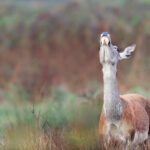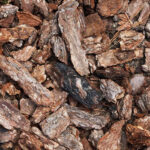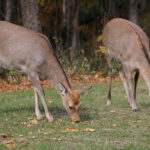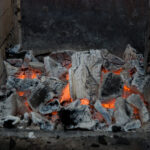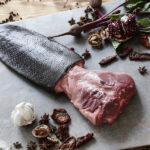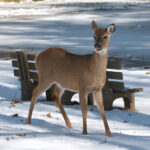Eating venison raw can be a tasty and healthy way to consume venison. But eating any meat raw has health risks and venison is no different.
From the wild to the kitchen, to your mouth, venison must be prepared in a sanitary manner to avoid possible contamination and health risks.
Table of Contents
Venison From The Source
If hunting deer for your own venison, there are a few things to consider when field dressing the deer and collecting the meat for consumption.
To reduce the risk of disease for you and the meat, wear disposable gloves while handling the animal and the meat.
Having a supply of clean water and alcohol swabs to frequently clean your tools is also recommended. This helps to avoid cross-contamination when dealing with the non-desirable parts of the deer carcass.
Avoid spoilage by properly cleaning dirt, feces, and entrails from the meat and ensure the carcass has proper air circulation when dressing and transporting.
If your venison smells sour or pungent, do not eat it! There is a good chance it is spoiled!
Once the deer has been dressed, transported, and processed, venison needs to be kept at cool temperatures, 40°F (4°C), until ready to consume. Any unfrozen meat should be consumed within 2 to 3 days.
Be sure to follow detailed instructions and health guidelines for a full breakdown of how to properly and safely field dress a deer.
If you’re not hunting and dressing the deer yourself, raw venison can be purchased from local hunters or deer farms. If consuming raw, it is important to trust the source of the venison.
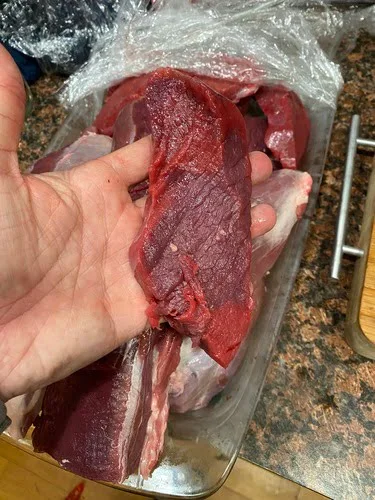
To reduce the risks of eating raw venison as much as possible, only buy meat from registered food producers to make sure sanitary measures are legally followed. It can also be helpful to ask the retailer questions about the venison’s origins.
When eating raw meat, it is important to know the conditions in which the animal was raised and its diet.
An animal that has not been exposed to excessive pesticides and antibiotics reduces the risks of consuming harmful bacteria that are present in factory-farmed meat.
Due to its natural diet, wild venison can be one of the safest options, if prepared in a sanitary manner. When buying farmed venison, look for organic, pastured deer farms to ensure the venison is as natural and bacteria-free as possible.
Eating raw venison is not the time to cheap out, so take the time to find a quality product.
Venison In the Kitchen
A common way to consume raw venison is to make venison tartare. This dish is prepared with minced or ground venison, raw egg yolks, and a variety of spices and seasonings.
Most recipes recommend using backstrap meat, the muscles that run along the deer’s spine, but you may also use tenderloin and a variety of edible organs.
The rules about safe sourcing and preparation of deer meat should also be followed with the eggs used in this recipe. Eating raw eggs creates the risk of salmonella poisoning.
Make sure to buy pasteurized eggs that have been treated to eliminate salmonella, while also looking for organic and free-range eggs to limit your risks.
Be sure to continue proper sanitary conditions when handling raw meat in the kitchen. First, freezing your meat, if it has not already been frozen, can kill many of the parasites that may exist in deer meat.
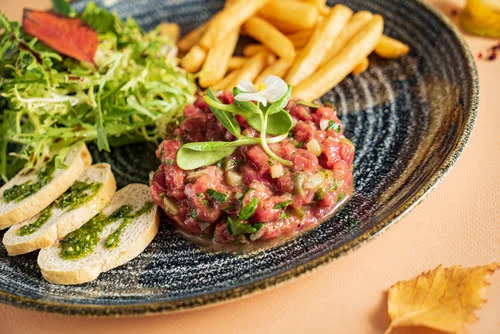
So freezing for at least two days before defrosting and consuming the venison is recommended.
Next, prioritize keeping the meat in the fridge when not preparing or handling it. Keeping the venison at a cool temperature prevents the risk of bacteria forming.
A good strategy is to only take out the meat that you will be mincing and return it to the fridge until all the meat is prepared one batch at a time and back in the fridge until ready to serve.
Like with dressing and butchering, clean tools and work surfaces go a long way in preventing food poisoning. Keep venison separated from other foods when in the fridge and when preparing.
Make sure to wipe down and disinfect all surfaces and tools that come into contact with the raw venison and wash your hands frequently.
If all sanitary measures are properly followed, eating venison raw can be a delicious experience. But still, no raw meat recipe is 100% safe.
Mistakes can happen from the retailer’s side and yours. Just be sure to be as careful and thorough as possible and take all necessary precautions to create a safe and healthy culinary experience.
You May Also Like: Can You Eat Venison Rare?
Benefits of Venison
Venison is a popular choice of meat as it can be a healthier alternative to beef. More often than not venison is more natural and will have fewer steroids and antibiotics than most farmed beef.
The meat itself is often leaner and has less fat, making it a healthier source of protein and other essential vitamins and minerals like iron and vitamin B12.
Venison also has a distinct and oftentimes, gamey flavor when compared to other meats. Whether cooked or raw, venison offers a chewier texture than beef, along with a rich and earthy flavor.
This flavoring can be further enhanced with fresh herbs like sage that create a truly unique red meat experience.
Venison, particularly deer liver, has been consumed raw by many indigenous cultures where deer were plentiful and an important part of their diet.
Using the whole animal, including the parts that can be consumed raw, is an important aspect of these cultures and an important lesson in today’s heavily wasteful global food system.
Raw meat recipes might not be for everyone and the risks detailed in this article must be considered.
But the experience of eating raw venison can create a closer relationship with your food and an appreciation of where your food comes from.
While being safe and educating yourself, being open to new food experiences can be a great thing!
